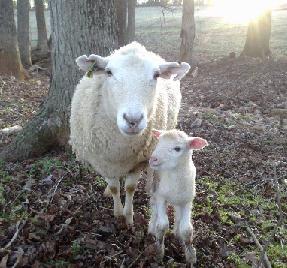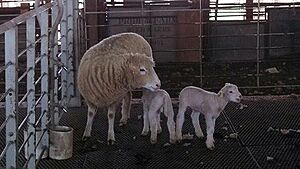Polled Dorset facts for kids

Ewe and lamb at the North Carolina State University Small Ruminant Unit
|
|
| Country of origin | USA |
|---|---|
|
|
The Polled Dorset is a special kind of domestic sheep from America. It's known for not having horns, which is why it's called "polled." This breed came from the British Dorset Horn sheep. It was developed in the 1950s at North Carolina State University after a unique natural change (a genetic mutation) led to a hornless ram being born. After careful breeding, a group of these hornless sheep was created.
Polled Dorsets are all white and medium-sized. They have many lambs and can breed at different times of the year. Their meat is good quality, and their wool is white. Today, more Polled Dorsets are registered in the United States than their horned relatives.
How the Polled Dorset Began
In 1949, something interesting happened at a farm at North Carolina State University in Raleigh. Four hornless lambs were born from a horned Dorset ram. Over the next five years, these four ewes (female sheep) and others on the farm were bred.
Eventually, one ewe gave birth to twin rams. One had horns, but the other, named NCSU 402, was born without horns. This was a big discovery!
Starting in 1956, the Polled Dorset was officially registered by the Continental Dorset Club. This club had been around since 1898. Scientists Dr. Lemuel Goode and Sam Buchanan are given credit for finding and developing this hornless sheep.
Other breeders bought the offspring of NCSU 402. Within 20 years, 70% of all registered Dorset sheep were polled. The Polled Dorset became very popular. It is now considered the second most popular sheep breed in the United States.
It's interesting to know that hornless Dorsets were also developed in Australia in the 1900s. However, those sheep were created by mixing different breeds, not from a natural genetic change like the American Polled Dorset.
What Makes Polled Dorsets Special?
The Polled Dorset is a medium-sized sheep. They live a long time and are very prolific, meaning they have many lambs. They are also heavy milk producers. Their lambs are strong and grow well. They produce good quality meat with lots of muscle.
Their fleece (wool coat) is very white and strong. It doesn't have dark fibers and grows down their legs. When they are shorn (have their wool cut off), a ewe's fleece usually weighs between 5 and 9 pounds (2.3 to 4.1 kg). About 50% to 70% of their fleece can be used.
The length of the wool fibers (called staple length) is about 2.5 to 4 inches (6.4 to 10 cm). The thickness of the fibers ranges from 27.0 to 33.0 microns.
Adult ewes usually weigh between 150 and 200 pounds (68 to 91 kg). Some may weigh more, especially if they are being shown. Adult rams (male sheep) weigh from 225 to 275 pounds (102 to 125 kg).
Dorsets are famous for being able to breed more than once a year. This is a special trait that only a few sheep breeds have. They are often used in crossbreeding programs to produce female sheep that can breed out of season. Having multiple births is common for them.
They work well in farms that raise sheep for business. This includes programs where rams are used to father lambs specifically for slaughter. These rams are called "terminal sires" because their genes are best for producing meat lambs, not for breeding more sheep.
Polled Dorsets on the Farm
Since the Polled Dorset breed became popular, it has spread to Canada. It is now a major part of the lamb meat industry there. These sheep adapt well to being kept in pens (confinement). They are also used in "accelerated crossbreeding programs," which means they help produce lambs faster.
Polled Dorsets do well whether they are eating grass or being fed in a feedlot. They are a good choice for smaller farms that are managed carefully.


